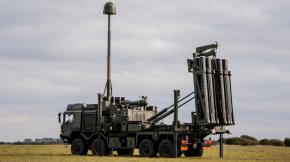First up, I think you are 100% right. We suffer from the curse of all Western armies, we have been conditioned since 1943 to fight under a (at worst) neutral sky. Korea, Vietnam, Cambodia, Rwanda, Iraq, Afghanistan, Timor - all were fought under even better conditions and we could ignore that element entirely. Now, thanks in large parts to the democratisation of UAVs, we have to think about something where our last SMEs were of my grandfather's era. The Russian's on the other had, they have an AD network designed to defeat us - so it's multi-layered and effective. If you have Twitter I highly recommend @gunner_schmulke for a looksee; he's heavily involved in Russian AD an offers some different views.
I agree with you 100% about DE. I do think it's the answer, but it's sill at least a decade away without a conflict to accelerate. Taking off the shelf I think you need 3 systems, and I unashamedly steal from the Russians! Exemplar system (ie, if its MK30-2 that could be an 25 - 40mm gun) would look similar to this:
AIM-120 based system to provide short range capability, tied into the Joint IAMDS system and operating primarily under their command (not the ground commander)...
RIM-116 based system for very short range / UAV capability. Tied into the Joint IAMDS system and BMS, but under command of the ground commander
MK30-2 based system for point defence of CT. Tied into BMS and under command of the CT commander.
I'll mix the last two onto a single system if needs be, but will also run individual platforms. I'm not a fan of the IM-SHORAD as the Hellfires draw attention away from AD (by the way, can we pause and laugh at the idea of an IM-SHORAD providing BMD like the website suggest?
Stryker A1 Initial Maneuver Short-Range Air Defence (IM-SHORAD)). A single platform for the guns or missiles (or a platform with RIM-116/MK30) also promotes expertise and puts an AD expert at the commander's table so have to be listened to.
If I could, I'd also seek to add a dedicated 12.7mm or (at a pinch 7.62mm) RWS/turret to all vehicles to provide last ditch point defence that you wouldn't waste an APS on/ I don't think it's possible; but this would then be replaced by the first, short range DEW. It also provides some APS redundancy, allowing vehicle commanders to use it on higher threats.
That's the kinetic effectors. Into that I'm going to add some EW. Three systems, an active and targeted EW system (like the person-portable ones that look like big railguns), an active and wide EW (designed to beat back command links and the like) and a passive EW system that disrupts our signature and includes decoys. I'm also going to add some more (many more) of those (again, stealing from the Russians) ranging from tanks to C2 nodes.
Finally, there are two cultural issues that I'd try and change. The first is convincing us to take the threat seriously. We pay lip service to AD (aim 6 aircraft lengths in front of the enemy fast jet -

) but we don't do it. Camouflage track plans? Overhead protection? Air raid drills? Hahahaha..... The second is that we will take casualties. We can't stop every rocket, UAV, bomb or artillery shell. We should understand this and try to mitigate, but also realise that the IAMD isn't going to catch all.
So not a simple answer, and there is a heavy does of cultural change which is
always easy. But it's something that we have to consider, as the RAAF simply can't achieve this mission (and that's technically, not because they wouldn't try). It'll also need some $$'s, which I think exist, especially if we use in-service munitions and platforms (hence RIM-116, AIM-120 and MK30). But, I'm not sure it's being taken seriously yet. I mean, we talk about it and write blog posts, but actual direction and commitment of effort and $$?

